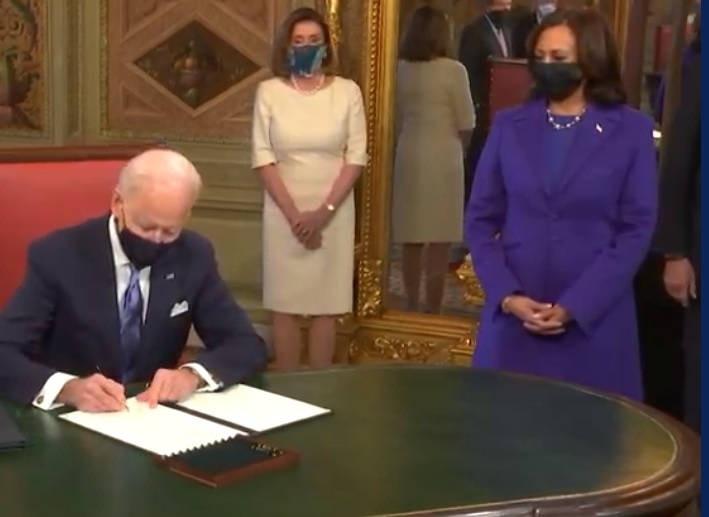India and the United States have hit the ground running for addressing common security concerns in the Indo-Pacific amid Chinese provocations which include threatening Taiwan with war.
During his first conversation earlier this week with his counterpart Jake Sullivan, National Security Adviser (NSA) Ajit Doval has stressed that New Delhi and Washington were “uniquely positioned” to impart “peace and stability in the Indo-Pacific region and beyond”.
Similarly, during a conversation with External Affairs Minister S. Jaishankar, Anthony Blinken, the new US foreign secretary singled out the Indo-Pacific region as a key area for collaboration.
So, why is the Joe Biden administration imparting such urgency to bond with India in the Indo-Pacific region? The obvious answer is China, and its stepped-up muscle flexing in the region including the South China Sea. Both India and the US are fully briefed and share common concern about the standoff between Indian and Chinese troops in Ladakh, which shows no signs of abating.
Barely had the 46th President of the United States, occupied the White House, Chinese military aircraft swarmed into Taiwanese air space, triggering the first round of military friction between the two rival powers.
The escalation began soon after the US carrier task force, led by the aircraft carrier Theodore Roosevelt entered the Bashi channel, sandwiched between Taiwan and the Philippines. The waterway is part of the Luzon Strait, which connects the Philippine Sea from the disputed South China Sea.
The Bashi channel, known for its windy storms in the rainy season, after the summer heat has abated, is of great strategic importance. Submarine cables connecting Southeast Asia’s internet with the rest of the world pass through this channel. Maintaining military dominance over this passage is therefore essential to keep Asia cyber-linked with the rest of the globe.
Furious with US naval patrols in the South China Sea, and hoping to trigger a policy shift under Biden, the People’s Liberation Army (PLA) virtually threw the kitchen sink at the new administration.
Chinese warplanes had reportedly simulated a strike against the Roosevelt carrier strike group after it had entered the Bashi channel. “Pilots of H-6 bombers could be heard in cockpit conversations confirming orders for the simulated targeting and release of anti-ship missiles against the carrier,” the Financial Times quoting its sources said.
Starting Jan. 23, the Chinese military flew 13 warplanes, including nuclear-capable H-6K bombers and fighter jets into the southwest corner of Taiwan’s air defence identification zone (ADIZ), The Japan Times reported. A day later, it dispatched 15 planes, including 12 fighter jets to the area. The US has extensive military ties with Taiwan, governed by the Taiwan Relations Act of 1979.
China’s focus on targeting US aircraft carriers in the South China Sea became visible last August when a series of ballistic missiles, including “carrier killer” weapons, were launched, during an exercise in these waters. Media reports then said that at least two of the missiles hit moving ship targets.
With no signs of China dropping its aggressive “wolf warrior” diplomatic style, and muscle flexing, the United States and India, during the latest round of conversations by the Biden administration team, have reaffirmed that working together in the Indo-Pacific region is necessary and urgent.
From an Indian perspective, there is growing realisation that in order to relieve pressure on Ladakh, New Delhi, with its partners including Japan, Australia and the United States, comprising the Quad, must develop capacity to impede the flow of Chinese commercial shipping along vital shipping lanes passing through Indian waters. More specifically, India would be looking for support from the Indo-Pacific Quad, to influence Chinese shipping flows along the 10 and six-degree channels in the Andaman and Nicobar chain of islands. Both these channels are the gateways to the Malacca straits—the bridge between the Indian and Pacific Oceans.
The website resonantnews.com is reporting that India has now also joined the much-speculated US-Japan “fish-hook” SOSUS (sound surveillance sensors chain), which has touched Andaman-Nicobar Islands. SOSUS is a sonar system which came into existence when US Navy was looking for a solution to counter submarine warfare. In 1951, US experimented its first array of hydrophones to target and deter Soviet submarines. But now a more sophisticated SOSUS, also called fish-hook (due to its shape and purpose) has replaced the older one, to track the PLAN (people’s liberation Army Navy, China) ships and submarines. It comprises arrays of hydrophones and magnetic anomaly detectors on the seabed, which work in coordination with maritime reconnaissance aircrafts to enable a multi-tier ASW (anti-submarine warfare) system.
On the Indo-US track, the two countries have already signed a series of “foundational agreements” that can propel their military partnership in the Indo-Pacific.
In 2016 the two had signed a Logistics Exchange Memorandum of Agreement (LEMOA), which allows them to move their war material and assets in the region. Last year they signed the Basic Exchange and Cooperation Agreement (BECA). Under BECA, the US will share its geospatial intelligence with India in real time. This will be especially helpful in guiding automated weapons such as missiles and drones to their targets with pinpointed accuracy, including Chinese long-range missiles, which have been arrayed in Tibet, facing Ladakh.




















